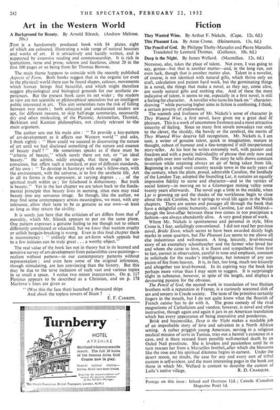Art in the Western World
Thus is a handsomely produced book with 84 plates, eight of which are coloured, illustrating a wide range of natural beauties and works of, art. It is attractively and lucidly written, and is `supported by extensive reading and connoisseurship. It is rich in quotations, verse and prose, solemn and facetious, about 20 in the first 100 pages or so being from Sir Thomas Browne.
The main theme happens to coincide with the recently published Aspects of Form. Both books suggest that in the organic (or even in the physical) world there can be found shapes, colours, movements which human beings find beautiful, and which might therefore suggest physiological and biological grounds for our aesthetic ex- periences. But the present book casts its net wider ; the readers in view are not scientific or philosophical specialists but an intelligent public interested in art. This aim sometimes runs the risk of falling between two stools ; both educated and uneducated readers are apt, for different reasons, to skip half-page summaries, necessarily dry and often misleading, of the Platonic, Aristotelian, Thomist, Berkleian and Kantian philosophies, not closely relevant to 'the main argument.
The author sets out his main aim : " To provide a key-pattern of art-development as it affects our Western world " and asks, I think rightly : " How could we succeed in discovering the nature of art until we had disclosed something of the nature and essence of beauty itself ? " He sometimes speaks as if there must be "criteria of beauty," which surely there are not, or "an ideal beauty." He admits, oddly enough, that these might be un- conscious, but offers such a standard, or pair of different standards, of his own : " To develop in harm?), with one's fellow-men, with the environment, v. ith the universe, is to live the aesthetic life. Art in all its forms is the expression, at varying degrees . . . of the spiritual truth within us ; for falsehood is disharmony. But truth is beauty." Yet in the last chapter we are taken back to the funda- mental principle that beauty lives in seeming, since men may read beauty into any sensuous image. So though, like the author, we may find some contempsrary artists meaningless, we must, with any tolerance, allow their taste to be as genuine as our own—at least so long as they return the civility.
It is surely just here that the criticism of art differs from that of morality, which Mr. Silcock appears to put on the same plane. One pattern expresses a genuine feeling to me though not to others differently constituted or educated, but we know that wanton cruelty or selfish bargain-breaking is wrong. Even in this final chapter there is inconsistency : " unlikely that an art-form which appeals but to a few initiates can be truly great . . . a worthy object."
The real value of the book lies not in theory but in its learned and sensitive survey of art-development from palaeolithic cave-paintings- realism without pattern—to our contemporary patterns without representation ; and even here some of the original inferences, though stimulating, are less convincing than the history. But this may be due to the terse inclusion of such vast and various topics in so small a space. I notice two minor inaccuracies. On p. 117 Plotinus appears to be described as a Christian, and on p. 178 Marlowe's lines are given as " (Was this the face that) launched a thousand ships And shook the topless towers of Ilium ?
E. F. CARRITY.


































 Previous page
Previous page